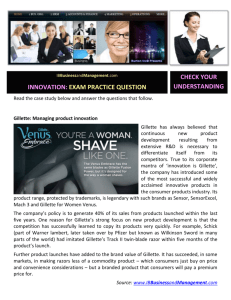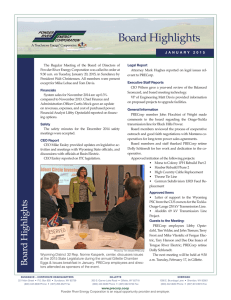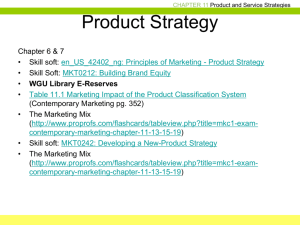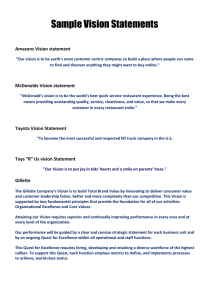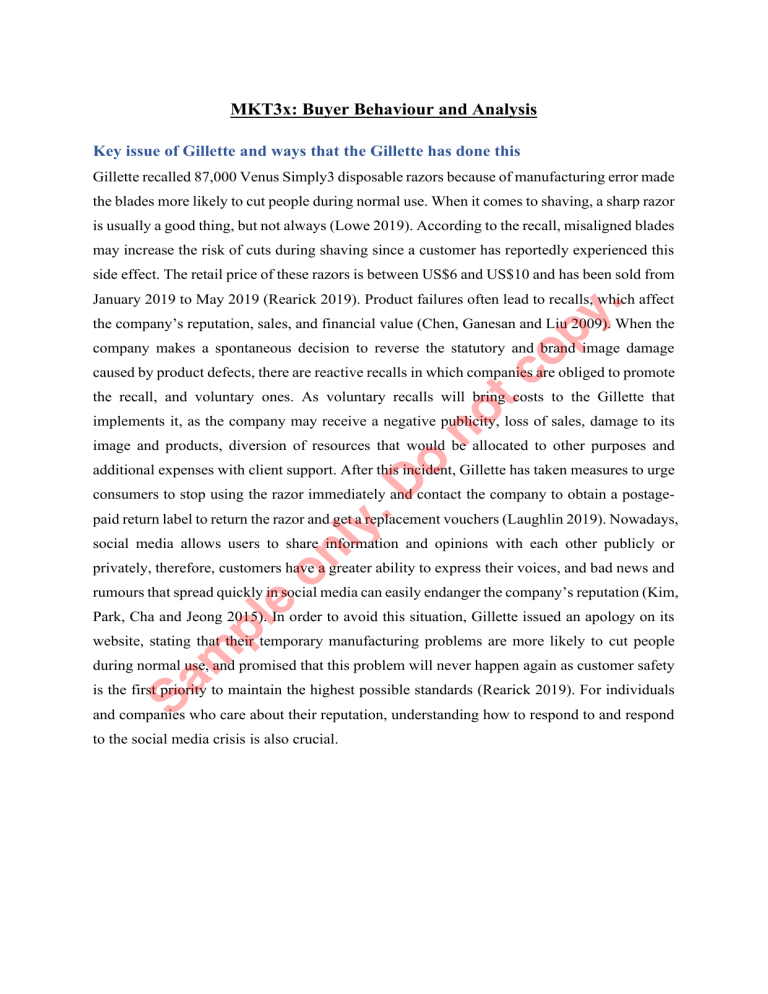
MKT3x: Buyer Behaviour and Analysis Key issue of Gillette and ways that the Gillette has done this Gillette recalled 87,000 Venus Simply3 disposable razors because of manufacturing error made the blades more likely to cut people during normal use. When it comes to shaving, a sharp razor is usually a good thing, but not always (Lowe 2019). According to the recall, misaligned blades may increase the risk of cuts during shaving since a customer has reportedly experienced this side effect. The retail price of these razors is between US$6 and US$10 and has been sold from y. January 2019 to May 2019 (Rearick 2019). Product failures often lead to recalls, which affect op the company’s reputation, sales, and financial value (Chen, Ganesan and Liu 2009). When the company makes a spontaneous decision to reverse the statutory and brand image damage tc caused by product defects, there are reactive recalls in which companies are obliged to promote no the recall, and voluntary ones. As voluntary recalls will bring costs to the Gillette that implements it, as the company may receive a negative publicity, loss of sales, damage to its o image and products, diversion of resources that would be allocated to other purposes and .D additional expenses with client support. After this incident, Gillette has taken measures to urge consumers to stop using the razor immediately and contact the company to obtain a postage- ly paid return label to return the razor and get a replacement vouchers (Laughlin 2019). Nowadays, on social media allows users to share information and opinions with each other publicly or privately, therefore, customers have a greater ability to express their voices, and bad news and e rumours that spread quickly in social media can easily endanger the company’s reputation (Kim, m pl Park, Cha and Jeong 2015). In order to avoid this situation, Gillette issued an apology on its website, stating that their temporary manufacturing problems are more likely to cut people Sa during normal use, and promised that this problem will never happen again as customer safety is the first priority to maintain the highest possible standards (Rearick 2019). For individuals and companies who care about their reputation, understanding how to respond to and respond to the social media crisis is also crucial. Recommendations on what Gillette could have improved or done differently Consumer decision-making approach As Gillette sells razors as their core business, it can adopt consumer decision-making approach to help Gillette extend their product line. There are three types of consumer decisions to consider which are extended decision making, limited decision making, and habitual decision making. In limited decision making, consumers search less for information and reach decisions based largely on prior beliefs about products and their attributes. For example, if consumers go to the shopping centre with every intention to make a selection from the particular brand of y. razors, but when they arrive, they notice that another razor is on discounts. A customer's op memory tells them that they have used this razor before, but found it is too expensive for their regular shopping habits, so they decide to make a change for a limited time and purchase the tc alternative razor instead. When customers choose the alternatives to shave with a razor, they no see the price of Gillette March 3 Sensitive Razor is $16.00 that comes with 4 pack and the price of Schick Quattro Titanium Razor is also $16.00 but comes with 8 pack, they are more likely o to choose the brand of razor with a reasonable price and the value to save their money. This .D argument could be taken when limited decisions is made due to the loss of brand loyalty. Therefore, consumers can be attributed to anything with the extent of the novelty of new ly products to a feeling of boredom based on their currently shopping habit (Carter 2017). on With habitual decision making, consumers do not seek information at all when a problem is recognized. Despite some people might say they will never use Gillette again, but the buying e habits, especially with something as habitual as a razor, are difficult to change. Most people m pl will not follow the threat of critical feedback even when they saw it on the social media (Dreyfuss 2019). For the limited income families, they will think that buying food or personal Sa hygiene products are not habitual but a significant decision for them. Due to the frequent price changes, this forced them to make a deep consideration of the product. Thus, the purchase decision-making approach was discovered not to be habitual but there are low amount of purchase risk and product involvement (Chikweche, Stanton and Fletcher 2012). In extended decision making, consumers move diligently through various problem-solving activities to find the best information that will help them reach a decision. They require a lot of involvement and there is a high risk. Some people don’t buy razors every day, they wanted to make sure that they have made the right choice from the selected brand quality. They may ask for advice from friends and family about how good and safe of the razor is. As a result, limited decision making can be applied to help Gillette to extend their product line because it can help to reduce the discrepancy from a variety of brands like Gillette, Bic and Schick within the razor product category. The attitude-toward-the-object (ATO) model Gillette can change attitudes by using the ATO approach in order to command a large market share of a product line over their competitors. ATO approach is an attitude towards the object, which has three main key elements to analyse consumers’ attitude. Firstly, it contains the attributes that consumers consider for any object, the second is the evaluation of the product, and the third includes the strength of the belief (Kumar and Jelsy 2013). Consumers have a y. different attitude towards a different product, and this approach is useful in any decision op making. For example, I want to buy a Tupperware plastic bottle, I am concerned about the tc quality and the price and colour, so these are the attributes I consider while buying a product and accordingly I will give them ratings, quality = 9 and then for Price= 6 and for colour 8, so no that is my attitude towards the product. Gillette can change the attitude by improving the ratings or by adding more attributes. For instance, Gillette produces razors that are environment- o friendly, so people who are concerned about nature and prefer environment-friendly products, .D they will give more importance to it. People's attitude will change towards Gillette and buy it more often than any other product because the value and benefit they get from Gillette may not on ly be received by other brands. The following Table 1 and 2 depict two different brands of razors which are Gillette and Bic. e b (b) (e) Attribute e b (b) (e) Sharpness 2 8 16 Sharpness 2 5 10 Safety 3 9 27 Safety 3 6 18 Price 2 4 8 Price 2 8 16 Quality 3 8 24 Quality 3 6 18 Environment friendly 3 9 27 m pl Attribute e Table 2 – Bic Sa Table 1 – Gillette 62 102 Note: e is the importance for that particular attribute which is between -3 to 3. b is the believe which is from 0 to 10. Table 1 shows how consumer’s attitude changes when one more attribute is added, and the average rating will increase for the product. Therefore, the consumer’s attitude can be changed by improving the ratings for the attributes. If Gillette has better quality than the Bic razors, this will change consumer’s attitude towards Gillette as they are more preferring to buy it rather than Bic. As a result, Gillette has more overall rating of (102) and Bic has only (62) which will change customer’s attitude (Bushkill 2015). Social Judgment Theory and Balance Theory Gillette can change the consumers’ attitude toward Sensor by using the social judgment theory and the balance theory. y. The social judgment theory helps to explain how consumers react to the new information and op compare the information with what they already know. When new information is negatively reacted to by consumers, this falls into the latitude of rejection. New information can fall into tc the latitude of rejection when the new information is not consistent with the consumers' initial knowledge. When new information is positively reacted to by consumers, this goes into the no latitude of acceptance. This is when new information is consistent with the initial information that the consumer had. It is far greater than new information will fall into the latitude of .D o rejection than acceptance because of many factors that may skew or distort a consumer’s initial knowledge. It is easier to get new information into the latitude of acceptance when there is no ly initial information (Cummings and Ostrom 1982). This is called an original attitude position; on it is easier as the consumer has nothing to compare the new information with. Gillette can use the social judgment theory by staying consistent to the information they have previously e provided in the past, that can slowly change their attitude towards the sensor or by targeting m pl new consumers that new to the product and having the ability to completing change their Sa attitudes towards the sensor as do not have information to compare with. Balance theory is a theory in which the relationship with the three components must be balanced. In the case of Gillette, the three components are Gillette, consumer, and a celebrity. If one component has a negative relationship with another or both component it does not balance. For example, if consumers think that the company does not like the celebrity, this may cause consumers to dislike Gillette as they have a positive relationship. This means that Gillette have to create a negative relationship with the celebrity to fix the relationship with the consumer y. (Study.com 2019). By using the balance theory, Gillette can find a celebrity like Cristiano op Ronaldo, a celebrity who has a good record and positive relationship with consumers to be their ambassador because Ronaldo is a proven celebrity, liked by the demographic of men that shave tc and is consistent with image of the sensor. The celebrity can change consumers mind who did not consider Gillette before but are fans of the celebrity and reinforce repeat consumer’s Sa m pl e on ly .D o no attitudes. REFERENCES Bushkill, Claire. 2015. "ATO - Attitude-Toward-the-Object Model,” Weebly (blog), March 1, 2015. https://bushkill.weebly.com/blog/ato-attitude-toward-the-object-model. Carter, Rebekah. 2017. “Understanding the 3 Types of Consumer Buying Decisions.” Guided-Selling.org. https://www.guided-selling.org/types-buying-behavior/ y. Chen, Yubo, Shankar Ganesan, and Yong Liu. 2009. “Does a Firm’s Product-Recall Strategy op Affect Its Financial Value? An Examination of Strategic Alternatives during ProductHarm Crises.” Journal of Marketing 73 (6): 214-226. https://www-jstor- no tc org.dbgw.lis.curtin.edu.au/stable/20619070?seq=1#metadata_info_tab_contents Chikweche, Tendai, John Stanton, and Richard Fletcher. 2012. “Family purchase decision o making at the bottom of the pyramid.” Emerald Group Publishing 29 (3): 202-213. .D https://search-proquest- ly com.dbgw.lis.curtin.edu.au/docview/1008637920/514D4067672A4F0BPQ/182?accou on ntid=10382 e Cummings, William Theodore, and Lonnie L. Ostrom. 1982. “Measuring Price Thresholds m pl using Social Judgment Theory.” Journal of the Academy of Marketing Science 10 (4) (Fall 1982): 395. https://search-proquest- Sa com.dbgw.lis.curtin.edu.au/docview/224865755/E69892E7E7C24E4BPQ/1?accounti d=10382 Dreyfuss, Emily. 2019. “Gillette’s Ad Proves The Definition Of A Good Man Has Changed.” WIRED, January 16, 2019. https://www.wired.com/story/gillette-we-believe-ad-menbacklash/ Kim, Hoh, Jaram Park, Meeyoung Cha, and Jaeseung Jeong. 2015. “The Effect of Bad News and CEO Apology of Corporate on User Responses in Social Media.” PloS One 10 (5): 1-22. https://journals.plos.org/plosone/article?id=10.1371/journal.pone.0126358 Kumar, N. Anil. and Joseph Jelsy. 2013. "An Assessment of Consumer Behavior, A Study with Specific Reference to Brown Goods(CTV/HTS) At Kochi Metro." I-Manager's Journal on Management 7 (4): 14-34. https://search-proquest- y. com.dbgw.lis.curtin.edu.au/docview/1473906552?accountid=10382. op Laughlin, Frank O’. 2019. “Gillette recalling 90,000 women’s razors due to increased risk of tc laceration.” 7 News Boston, June 27, 2019. https://whdh.com/news/gillette-recalling- no 90000-womens-razors-due-to-increased-risk-of-laceration/ o Lowe, Lindsay. 2019. “Gillette recalls Venus razors that could pose a ‘high risk of cuts’ during .D shaving.” Today, July 8, 2019. https://www.today.com/style/gillette-recalls-87-000- on ly venus-razors-due-high-risk-cuts-t157831 Rearick, Lauren. 2019. “Gillette Announces Recall of Venus Simply3 Disposable Razors.” e Teen Vogue, July 6, 2019. https://www.teenvogue.com/story/gillette-recall-venus- m pl simply3-disposable-razors Sa Study.com. 2019. “Balance Theory in Psychology: Definition & Examples.” Study.com. Accessed May 13, https://study.com/academy/lesson/balance-theory-in-psychologydefinition-examples.html


